I did not know any fly anglers while growing up here, in the River Valley region of Arkansas. I read about them in the pages of Field & Stream and Sports Afield. I remember one named Lefty and another fellow named Wulff. But my fishing heroes drove fiberglass boats and threw the patently pagan Texas-rigged scuppernong Jelly Worm as opposed to the cultured and elegant-sounding Royal Coachman. I’m pretty sure you would have been laughed out of the fishing aisle at Wal-Mart if you mentioned a Royal Coachman, impressionistic flies or nymphing (which, if you know anything about Greek mythology, sounds a lot like what we were trying to do as teenagers cruising the town).
Fishing tactics in cracker culture are pretty crude and utilitarian. They involve casting, flipping or pitching hunks of plastic, or gobbing live bait on a hook. Sometimes we let trotlines hold the bait while we sit around the fire. And sometimes we don’t even use bait. We’ve snagged a lot of fish with 8/0 treble hooks and have shot a lot of fish with bows and arrows. Though I never participated, my dad often talked about late winter sucker gigging in the Ozark streams of his youth. All of these tactics are about maximum yield of fish flesh. Like I said, utilitarian. Style and challenge, beyond the live bait vs. artificial discussion, weren’t part of the equation.
But ideas of a more sophisticated way to catch a fish sprang from reading about those fly fisherman (there were no fly fisherwomen that I was aware of at the time) and one day, when I was about twelve, I tracked down and bought some poppers. There was a yellow popper and a red and white popper in the package, and I thought the yellow one looked enough like a midsummer grasshopper to fool the little bass in my grandparent’s pond. It was my first venture into matching the hatch. That afternoon I tied it on, a difficult task with 17-pound-test monofilament, and recalled the words of Lefty and Lee. I stripped line from my Shimano baitcaster, whipping the five-and-a-half foot heavy action bass rod back and forth, working the coils of line and reaching a bit further toward the middle of the pond with each false cast until finally the yellow popper rested on brown water. The ripples faded. One little tug and “bloop”, a feisty bluegill smashed the popper and gave a futile fight as I winched it in from 10 feet. It measured about five inches long but stands as my first catch on a fly.
Actually, that little bluegill still stands as my only catch on a fly.
But since that time, my taste in angling has veered toward refinement. Though I will still sit on the river sandbar soaking night crawlers for channel catfish, most of my fishing time and effort is focused on smallmouth bass. Spinning tackle has been the equipment of choice, and lure selection is your standard largemouth arsenal in miniature: four-inch plastic worms, tiny Rapala crankbaits and 1/8 ounce rubber-legged jigs tipped with pork rind. This jargon may sound foreign to many of you fly anglers, but I doubt it sounds more intimidating than the fly talk bandied about by guys like Todd Tanner, who has been gracious enough to advise this greenhorn since I mentioned fly fishing as the next step in my evolution as an angler.
Me: “I don’t even know where to start, Todd. What are the different pound-test lines they make for fly fishing? I’ll be catching mostly 10-12 inch smallmouth bass.”
Todd: “Johnny, we go by line size, rather than breaking strength. You’ll probably want a five or six-weight rod for those little smallmouth bass.”
Me: “Six-weight rod? I asked about line, man. Why does the weight of your rod matter? I use six-pound test line on my spinning rig.”
Todd: “We try to match the rod weight and the line weight, and we pick the line weight based on the type of flies you’ll be casting, as well as the size of the bass you’re fishing for. Oh, and we should talk about leaders and tippets as well …”
Me: “So your line and your rod need to be the same pound-test rating? Leaders? Why do you need a leader for bass? ”
Todd: “Well … almost. And the leader is for… um… I’ll get to that a little later. Anyway, we base your rod and your line on the size of the flies you’ll be throwing.”
Me: “So my rod is sized to my bait instead of the fish I’m trying to catch? That doesn’t make any sense, Todd.”
Todd: “Yeah, it’s definitely a little more complicated than spin fishing.”
Me: “How do you get that big line through those tiny hook eyes? I tried to do that with 17-pound-test monofilament one time and it was a pain, and that fly line y’all use looks big around as a rope.”
Todd: “Okay, let’s back up for just a second …”
But ignorance be damned, there’s a fly rod and reel on its way to my home right now. I expect to be rigging up and cussing in my yard by this time next week, learning the craft and opening up what my wife suspects to be another Pandora’s box of outdoor obsession.
The catalyst for buying those poppers so many years ago was catching more fish, but the reasons I’ll be fly fishing now are complex. I think it’s predicated on a desire for singularity with the water and the fish. Yeah, that sounds like hippie talk, but it’s true. I expect to catch fish, but I also expect to know the creek on a more intimate level, to know that crayfish in Big Creek are a different species than those found in Piney Creek, and to choose my fly accordingly. As a deer hunter, the best analogy for me is bowhunting. If you’re bowhunting, knowing that a deer feeds in a certain oak flat is not good enough. You must know which tree it prefers to feed under.
I’m already dreaming of summer afternoons in the water — cicadas buzzing, dragonflies patrolling and creekside weeds heavy with grasshoppers. I’ll be looking for the bronze flash as a hapless hopper misjudges his flight and falls to the water. And with a smile from the river gods, maybe I can add another fish or two to my fly angling tally.

















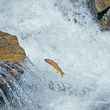




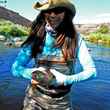



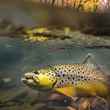
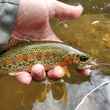



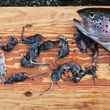
Comments
Matthew CA replied on Permalink
Great article! So many of us have been there, and unfortunately too many forget that. Good luck!
Johnny Carrol Sain replied on Permalink
Thanks, Matthew!
UPDATE: My Echo rod and reel arrived last night. After spending the late morning researching the Bimini twist and various other obscure knots, I finally started chucking a tiny piece of pipe cleaner around the yard and proceeded to burn the entire afternoon casting to leaf piles and twigs.
CONCLUSION: This fly rod thing is a helluva lot of fun. Water and fish will surly push me over the edge into deep obsession.
backcountrychronicles replied on Permalink
Amen Brother... I resemble that remark.
I also had trouble making sense of the fly line weight/fly size thing and fly size/tippet combinations. I found it useful to look at tables showing the size of flies that can be cast with different weight line and fly size/tippet combinations.
Pages